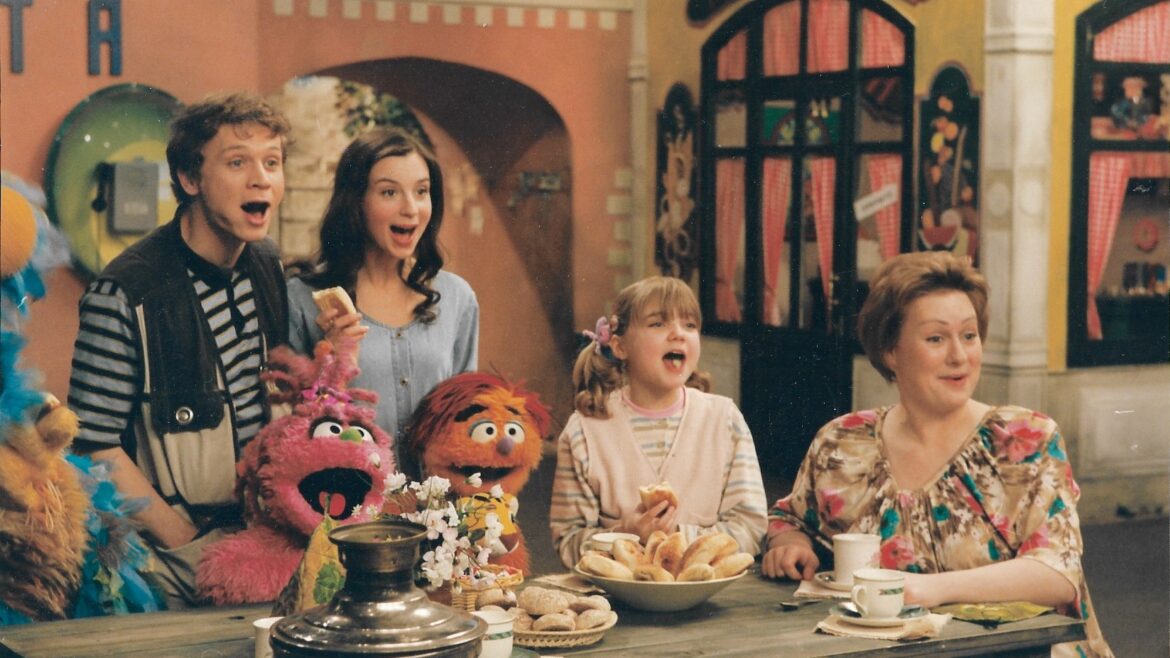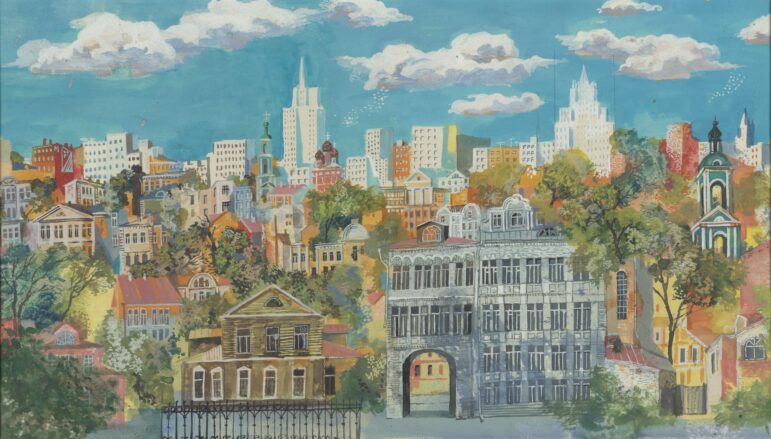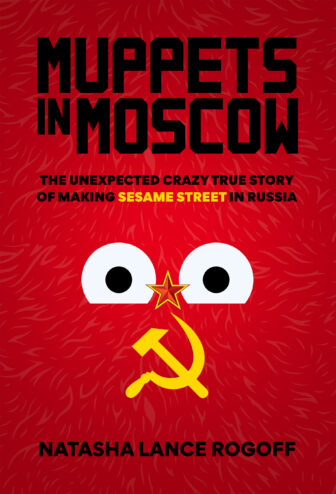How ‘Sesame Street’ took root in post-Soviet Russia as ‘Ulitsa Sezam’

Courtesy of Tatiana Mikhailovskaya
"Ulitsa Sezam" actors singing on set: Alexander Lyrchikov (father Sasha), Ekaterina Strizhenova (mother Nina), Muppets Businka and Kubik with Katya Mikhailovskaya (young Katya), and Maria Aronova (Aunt Dasha).
With the title Muppets in Moscow: The Unexpected Crazy True Story of Making Sesame Street in Russia, the new book by Natasha Lance Rogoff promises a lot. Could the saga of Rogoff’s work on creating Ulitsa Sezam, the Russian version of Sesame Street, really be that crazy? Indeed it can. Sesame Workshop’s push to create the show, with Rogoff in charge as EP, encountered so many hurdles and setbacks that it’s remarkable it came to be at all. In the book, Rogoff vividly recounts the story that unfolded in post-Soviet Russia, illuminating how creative teams overcame daunting cultural differences to create a uniquely Russian kids show. In this excerpt, Rogoff brings Ulitsa Sezam art director Masha Rybasova to the set of her show’s American counterpart for the first time.
It was Masha’s dream to visit Sesame Street in New York. While designing the Russian set, she’d immersed herself in the American show’s folklore, and now the day has come for her to visit the studio where it all began in Queens. I’m there too—back home for two weeks.
The moment Masha sets foot on America’s most famous street, she stops dead in her tracks, stunned by its enormity and the amount of equipment. Craning her neck toward the ceiling, she stares at the lighting grid—crisscrossing metal tracks running the length of the studio and the elaborate, detailed scenery filling every inch of the studio.
I see her eyes widen, realizing she probably doesn’t recognize even a quarter of the technology in the studio. Russian television equipment is eons behind the West.
She notices the painted scenery panels hanging from cables suspended from the ceiling and asks, confused, “Why is the scenery hanging from the ceiling?”
Before I can answer, Lisa Simon, the American director, calls for the actors to return to the set. They resume their positions, standing in front of the suspended scenery panels, which are level with the top of their heads. Each puppeteer raises the arm that supports a Muppet and begins performing. The camera films the action taking place above the puppeteers’ heads framed against the scenic panels. Masha watches in awe as the puppeteers move comfortably, manipulating puppets while standing. Masha clasps her hands together as though in prayer.
“This is sheer genius!”
“Yup—the genius of Jim Henson,” I respond, taking pleasure in her joy. I whisper to her that working with these heavy foam and fabric Muppets is physically draining, and Jim Henson came up with the suspended scenery panels to allow the puppeteers to preserve their energy and backs.
Masha walks around the studio, ogling the realistic-looking scenery and props. When she sees Big Bird’s nest, she lifts her tiny frame over the top rim and peeks inside. Her eyes dart from one detail to another, taking it all in with hungry eyes. She sits on the famous brownstone stoop between live takes and asks me to take her photograph.

The American producers and puppeteers greet Masha like a soldier on leave from the front. For months, they’ve heard about the trials and tribulations of the Russian production and are all happy to help. Masha gingerly retrieves the Ulitsa Sezam set plans from her satchel. Victor DiNapoli, Sesame Street’s art director, spends half a day with her, going over her detailed drawings and miniature maquette. He suggests repositioning scenery and props to optimize the set for shooting puppets—creating more hiding places for the puppeteers when they’re performing.
Masha is initially quite deferential to Victor, but the two artists quickly find a common language that has nothing to do with my translating. It’s gratifying to see.
After a few hours with Victor, we return to the studio and talk with the chief audio engineer, the lighting director, and camera operators who offer valuable insights. Trailing behind, I translate and videotape these conversations for later reference when Masha returns home. Finally, she pauses her interrogation of my Sesame Street colleagues, turns to me, and says, “I think we can do this, but we will need a lot of help.”
“We are here for you,” I reassure her.
The crew sets up another scene. Rosita, Sesame Street’s first bilingual Spanish-English-speaking Muppet, performed by Carmen Osbahr-Vertiz, positions herself on a rollie, a small rectangular cart on wheels. Crouching down so that the top of her head clears the camera frame, Carmen extends her arm upright in the air to operate Rosita while resting her back on a foam back support. Masha watches how Carmen uses her feet to move the cart, which allows more controlled and smoother movement of the Muppet. The director yells, “Cut.”
As the crew is resetting for the next scene, Masha walks over to the cart: a flat, rectangular-shaped piece of wood covered in foam with rubber wheels attached to the bottom. She gently pushes the cart, marveling at how smoothly it rolls over the floor.
I tell her that the cart is indispensable to the puppeteers, who use it to perform even small movements like when the Muppets rock back and forth in laughter. Masha notes there are tremendous shortages in Moscow, and we will need to purchase the rubber casters, hinges, and wood in America to allow for their reproduction in Moscow, as well as hundreds of boxes of nails. By the end of the day, I joke with her that the list of items she needs me to ship to Moscow looks like a wartime requisition list to supply half a million troops. She just nods. We both know that shipping anything to Russia will be a nightmare involving an insane amount of paperwork, not to mention the high customs fees and the likelihood of damage or theft.
While we’re talking, I notice that Masha is gasping at the sight of Elmo, performed by Kevin Clash. “Oh, I can’t believe it! That’s Elmo!” she murmurs, excited as a four-year-old.
“Do you want to meet him?” I ask.
Masha, overcome with emotion, can barely respond. We walk over to Kevin, who is goofing around with his Muppet while waiting for filming to begin again.
In Elmo’s three-year-old, high squeaky voice, he says, “Elmo wants to meet you.”
Masha bends her head so far down in embarrassment that she nearly disappears around Kevin’s knees. Leaning in closer to Masha, the Muppet softly encourages, “Elmo says, don’t be afraid.”
Masha starts giggling and covers her mouth.
Kevin’s called to the set, and after filming a scene, invites Masha to join him in the lounge reserved only for the puppeteers. Not quite believing her good fortune, Masha follows him.
“It is such an honor for everyone at Sesame Street to meet you and to be a part of helping Russia,” Kevin acknowledges as I translate. He is the perfect ambassador.
Masha nods, deeply touched. “My twelve-year-old daughter, whose name is also Masha, loves Elmo. I watched all the Sesame Street videos in English that Natasha gave me with my daughter.” Her voice catches at the end.
Kevin, who still has his arm inside Elmo’s slumped body, suddenly raises it, making Elmo’s head pop up—nearly knocking Masha off her feet in surprise.
“Really? Little Masha loves Elmo too?” Kevin asks in his character’s voice. And then, still in Elmo’s voice, impulsively offers, “Let’s call Masha’s daughter, so Elmo can say hello!”
“But it’s one o’clock in the morning in Moscow,” Masha protests. Kevin waves away her concerns. We spend the next few minutes teaching Kevin how to say in Russian “Elmo tebya lubit” (“Elmo loves you”) and “Spokoiny Nochi” (“Good night”).

I use the phone in the lounge and ask the studio’s operator to call Moscow. Masha’s husband answers and then wakes up their daughter. A minute later, we hear Little Masha’s small groggy voice. When she hears Elmo’s voice, she shrieks in delight, audible to the entire room.
We are all laughing, and I feel tightness in my throat. This moment is pure magic—watching Elmo’s high squeaky voice travel through the phone lines from New York to a little girl in Moscow to say, “Good night.”
Kevin hangs up the phone and wraps his skinny furry red arms around Masha’s tiny frame. She is so happy, even holding back tears. I’ve never seen her like this.
The green studio light starts flashing; shooting is about to begin. We return to the set.
Later that afternoon, I see Masha sketching in her notebook. I take a peek as she’s drawing ivy crawling on the faux brick apartment building on 123 Sesame Street. In Finders Keepers second-hand shop, Masha picks up a large plastic yellow pig and squeezes it, then runs her fingers over the full-body suit of armor in front of the store to see what it’s made of. She looks at me. “It’s steel,” she says.
Her favorite part of the American set is the arbor around the corner from the street.
“Are these real?” she asks, rubbing a leaf between her thumb and forefinger.
“They’re fake,” I say.
“We don’t have anything like these fake trees,” she says, shaking her head in disbelief. I remember that Masha’s set design calls for [Ulitsa Sezam Muppet] Zeliboba to live inside a tree and her drawings include a fifteen-foot-tall oak, and I get nervous. Are we going to have to ship an entire tree to Russia? Apparently, the answer is yes.
We go back to the art department, and Victor helps Masha look through scenic prop catalogs for the kind of oak leaves she wants. With each turn of the page, Masha shakes her head, “No, no, not that. Russian oak leaves are different from American oak leaves. Russian leaves have only six points and are rounded at the tips, whereas the American leaves have eight points and have pointy ends.” New York’s largest scenic design company has all the wrong leaves for Russia. She sketches the correct leaves from every angle to help us research where to find suitable foliage after she leaves.
I wanted to tell Masha that she should forget about her six-pointed oak leaves, but I can’t. “Every horticultural detail must be true to life if the audience is to believe in the show,” she says solemnly.
I admire her passion.
Excerpted from the book Muppets in Moscow: The Unexpected Crazy True Story of Making Sesame Street in Russia by Natasha Lance Rogoff. Used by permission of the publisher Rowman & Littlefield. All rights reserved.






